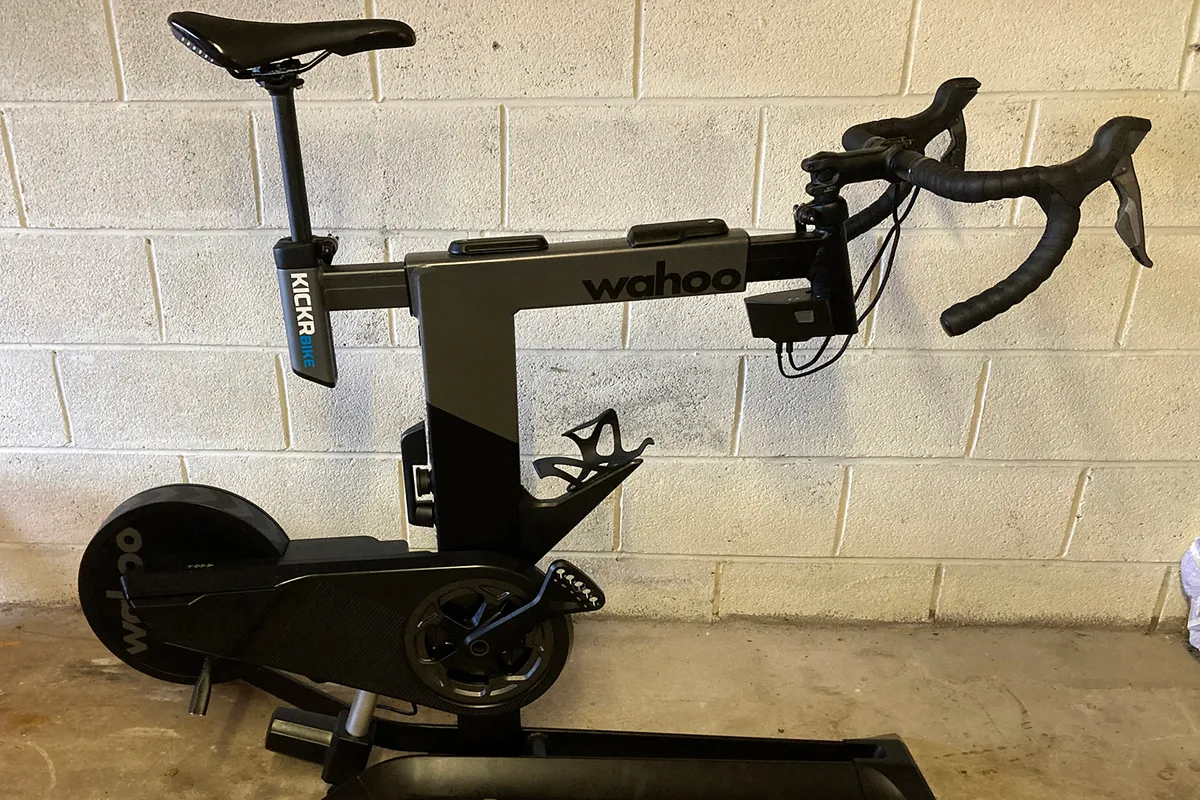The Wattbike has earned a reputation as a trainer for serious athletes.
With the Proton, the brand is looking to extend its reach to the wider fitness market, with easy setup and flexible fitting.
Thankfully, it has maintained its accuracy standards, while adding a slightly more accessible edge.
The Proton is priced at £1,795 / $2,499 / AU$3,749.
Wattbike Proton details and specification

Wattbike appears to be looking to take a slice of the Peloton and Zwift Ride pie and hit the wider health and smart trainer market with the Proton.
The Proton is designed to offer easy setup and maximum flexibility.
It can be adjusted without tools, for users ranging from 4ft 6in (137cm) to 6ft 6in (200cm) tall.
It weighs 48kg, but comes with wheels for mobility; the stored footprint is 98x102x57cm, setting up at 127x125x57cm.

The front flywheel weighs 8.05kg (the same as the range-topping Wattbike Atom), with electromagnetic resistance.
Wattbike says power readings are accurate down to +/-1 per cent, in line with the best smart trainers.
The maximum power output on the Proton is 1,800 watts, compared to 2,500 watts on the Atom – if you know you’ll be punching out the largest numbers in sprints, it’s obvious which one to go for. That said, most will be fine with the Proton’s capabilities.
There is a single crank-arm length option, at 170mm, which some might find limiting.
As you’d expect from a smart bike, you can connect to myriad apps such as Zwift and Rouvy, via Wattbike’s Hub app (which is subscription-free).

It connects via ANT+ and Bluetooth, but misses out on WiFi connectivity.
Virtual gearing can be tweaked to suit your needs, offering a variety of setups for road, gravel, pursuit, TT and other disciplines.
The other main differences are, according to Wattbike, the speed of resistance changes, which are quicker on the Atom (albeit we found this imperceptible), and greater rigidity. This is ostensibly down to the missing top tube.
The price of £1,795 / $2,499 / AU$3,749 might be inaccessible for many, but it’s certainly cheaper than the Atom, which costs more than £2,000.
Wattbike Proton setup process

Setup is extremely simple thanks to the Proton's ease of adjustability.
There are chunky knobs on the moveable stem, exaggerated head tube and seat tube for tweaking your cockpit and saddle height, respectively. There’s also a lever beneath the saddle to adjust fore and aft, which slides along a sizeable rail.
The front end on my pre-production model was a little metal-on-metal, friction-heavy, but Wattbike says it has identified this slightly screechy issue and told me it will soon be lined with a softer material.

Weighing 48kg, you might need a hand unboxing it or lifting it over the threshold on delivery. However, it’s easy enough to move the Proton to your chosen exercise spot by tipping it onto its front, where two solid plastic wheels are located.
Software setup is a simple affair, too. Just download the Wattbike Hub app and, as long as your Proton is plugged in via a cable at its rear (for power), you can connect via ANT+ or Bluetooth.
Wattbike Proton performance

Wattbike appears to have retained its performance-oriented DNA with the Proton, while delivering many positive features that cater for non-cyclists or new cyclists. It’s an impressive trainer.
The weight is similar to the Atom, but the Proton is arguably more usable – for the masses anyway – thanks to its low stepover height.
Where the Atom came in at 80.6cm sloping to 55.5cm, here it’s a slope between 44 and 46cm.
Resistance is electromagnetic, resulting in a very quiet ride. It’s also smooth through the pedal stroke and realistic-feeling.
That realism is contributed to by a little side-to-side play up front when putting power through the pedals, which feels more real-world than original Wattbikes that, while accurate, were stoically static.
Just watch out for the extended saddle rail if you have the saddle set far back – those with larger thighs could experience rubbing.
You can shift through the gears via two buttons on the shaft of the right hood; top equals upshift and bottom equals downshift.

These could be a little more pronounced as, certainly during the early stages of use, your digits are searching around. I soon got used to it, though.
There’s also a big red button on top of the hoods that screams of nuclear armageddon but changes from geared to Ergo mode.
Ergo mode enables you to select a target wattage and the resistance of your smart bike will be adjusted automatically to match the intended figure, independent of leg speed.

As for the left hood, the top and bottom buttons shift through the various data fields in the app. The data fields – presented on an iPad in my case – are clear and usable.
My data setup was split into two across the horizontal. The bottom half shows power, cadence, time elapsed, heart rate, lap time, which gear you’re in and whether you’re using manual gears or Ergo mode.
The upper half of the screen, which you shift through using those right buttons, shows you where you are on the specific workout. There's also a line graph displaying how power, heart rate and cadence change through the session.
And, of course, you’re given the data Wattbike became famous for: the Pedalling Effectiveness Score.

This is a graphic of concentric circles that shows how much power you’re putting through the pedal stroke plus the split between left and right legs. As your technique improves, that figure of eight should be ironed out because you’ve reduced the dead spot.
The Wattbike Hub is loaded with workouts, categorised by fitness parameters such as ‘endurance’ and ‘speed’, plus tests to gauge your progress. These include the 20-minute test to measure your functional threshold power (FTP), upon which many workouts are based.
There’s also a three-minute test to estimate your maximum minute power and the Wingate test, which is a brutal exercise to measure anaerobic capacity.

The new addition is the Run-Ride function, which hammers home that Wattbike is reaching out to people other than pure cyclists – running charted as the second-highest named sport selected by users of the Wattbike Hub.
Wattbike says it worked with Barney Wainwright from Leeds Beckett University (and formerly at the Boardman Performance Centre) on how best to use bikes for running performance. This meant not only the cardiovascular benefit, but also moving users into a position that can more directly support running, while easing the weight-bearing load of running – which can lead to injury.
This progresses by increasing out-of-saddle work, while Wattbike says it’s working on more direct building and run-replacement sessions, which should be with consumers shortly. I run a fair bit, too, and can certainly see the value in these.
Wattbike Proton competition

Should you buy the Wattbike Proton? By Wattbike's own admission, it's aimed at a broader fitness audience – but that’s underplaying its cycling credentials.
The ride feels very much like the Atom – its smoothness, real-world feel and quietness are a trinity of plus points that every cyclist should appreciate.
It connects seamlessly to third-party cycling apps and Wattbike’s own Hub, which features all the analysis, metrics and workouts you need. Importantly, it doesn’t require a subscription.
Does it match the Wahoo Kickr Bike V2 that I tested last year? Not quite.
The ride feel isn’t quite as realistic, it doesn’t tap into WiFi connectivity and it lacks the crank-length options seen on the Wahoo smart bike.
However, the Proton doesn’t cost £3,199 and isn’t aimed at the bonafide road cyclist.
Wattbike Proton bottom line

All in all, Wattbike has done a fine job with the Proton.
It’s a solid-looking, relatively compact smart bike that delivers an impressive riding experience.
The adjustability and removal of the top tube will certainly help it appeal to riders of many sizes and goals, and the subscription-free Wattbike Hub workouts are a bonus.
For the pure cycling enthusiast, the Atom clearly mimics a road bike more accurately than the Proton thanks to the top tube (which makes the setup feel even more stable for those out-of-the-saddle efforts).
But at £2,145, compared to the £1,795 for the Proton, there’s certainly a case for saving that £350 and spending it here.
Product
| Brand | Wattbike |
| Price | A$3749.00, £1795.00, $2499.00 |
| Weight | 48.00kg |
Features
| Trainer type | smart_trainer |
| Connectivity | antPlus |
| Connectivity | bluetooth |
| Flywheel weight | 8.0500 |
| Flywheel weight | KILOGRAM |
| Features | Adjustability means it suits individuals from 4ft 6in to 6ft 6in Maximum power output 1,800W +/- 1 per cent claimed power accuracy Wattbike app features ride sessions specifically for runners Works with third-party training apps including Zwift and Rouvy Steel |





